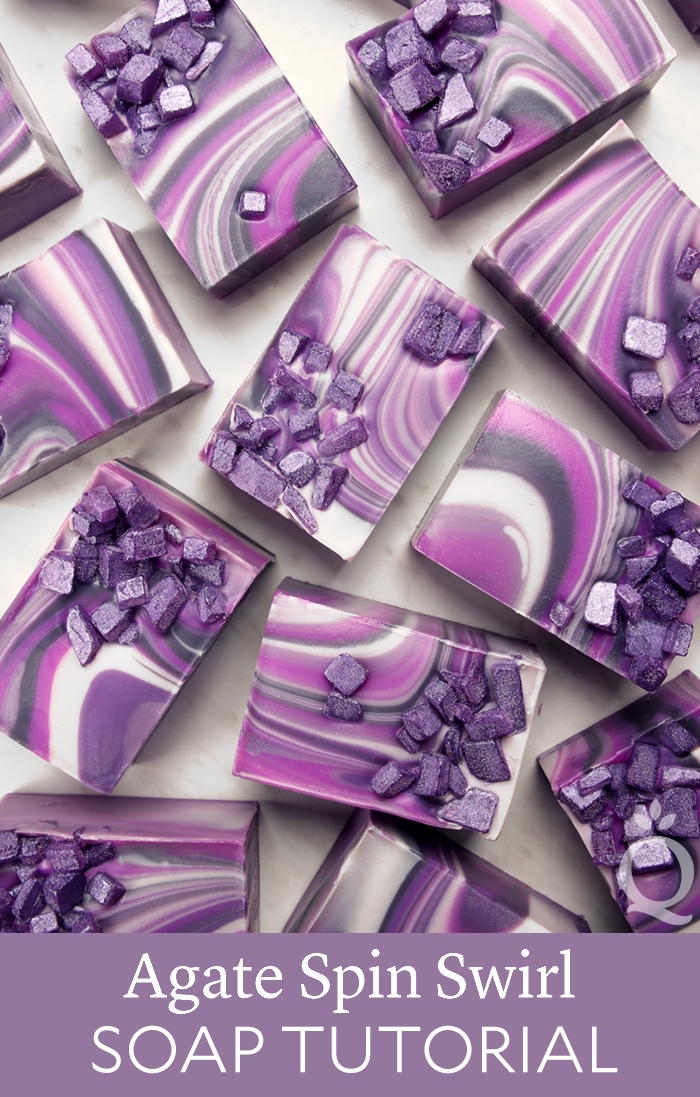
This Spin Swirl Soap is inspired by the beautiful layers and textures of agate stones. The design is created with a technique known as the “Spin Swirl.” It’s an advanced technique that involves layering colors of soap in the mold. Once the mold is full, it’s spun on a Lazy Susan or directly on the counter. The spinning motion causes the soap to swirl together. See the spin swirl in action here.
Once the soap is swirled, pieces of LCP Melt and Pour Soap Base are sprinkled into the corner of each bar. LCP soap base has less glycerin than regular melt and pour soap, which helps prevent sweating. But, because cold process soap needs to cure unwrapped, you may still experience some glycerin dew. Our bars got a little bit, but the glycerin dew actually added some extra “sparkle” to the embeds!
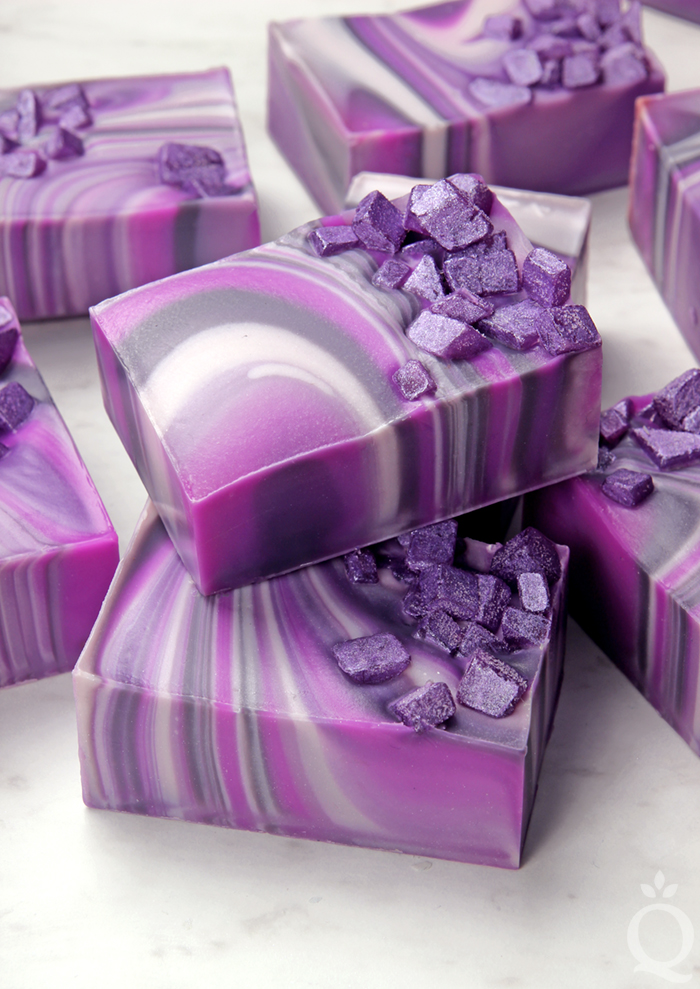
The key to the spin swirl is formulating a recipe that gives you plenty of time to pour all the layers. Once the layers are poured, the soap needs to be liquid enough to move during the spinning process. This recipe contains plenty of slow-moving oils like olive and apricot kernel. It also features the new Amethyst Fragrance Oil, which doesn’t accelerate in cold process soap.
If the soap needs to be fluid for a long period of time, you may be wondering why there is a water discount. The first time we made this soap, we experienced heavy soda ash on the bars. Soda ash is more likely to occur if the soap is poured thin and temperatures are kept cool, like this batch. A water discount is the best way to prevent soda ash. Luckily, even with the water discount, we were still able to create a spin swirl. Just remember to use your stick blender sparingly and work quickly.
What You’ll Need:
Embeds:
10 oz. LCP Clear Melt and Pour Soap
Lavender Mica
Snowflake Sparkle Mica
Base
18 Bar Birchwood Mold
Silicone Liner for 18 Bar Mold
8.1 oz. Apricot Kernel Oil (15%)
13.5 oz. Coconut Oil (25%)
21.6 oz. Olive Oil (40%)
10.8 oz. Palm Oil (20%)
7.6 oz. Sodium Hydroxide Lye
15.1 oz. Distilled Water (15% water discount)
3.5 oz. Amethyst Fragrance Oil
Titanium Dioxide
Black Oxide
Queen’s Purple Mica
Lavender Mica
Radiant Plum Colorant

Click here to add everything you need for this project to your Bramble Berry shopping cart!
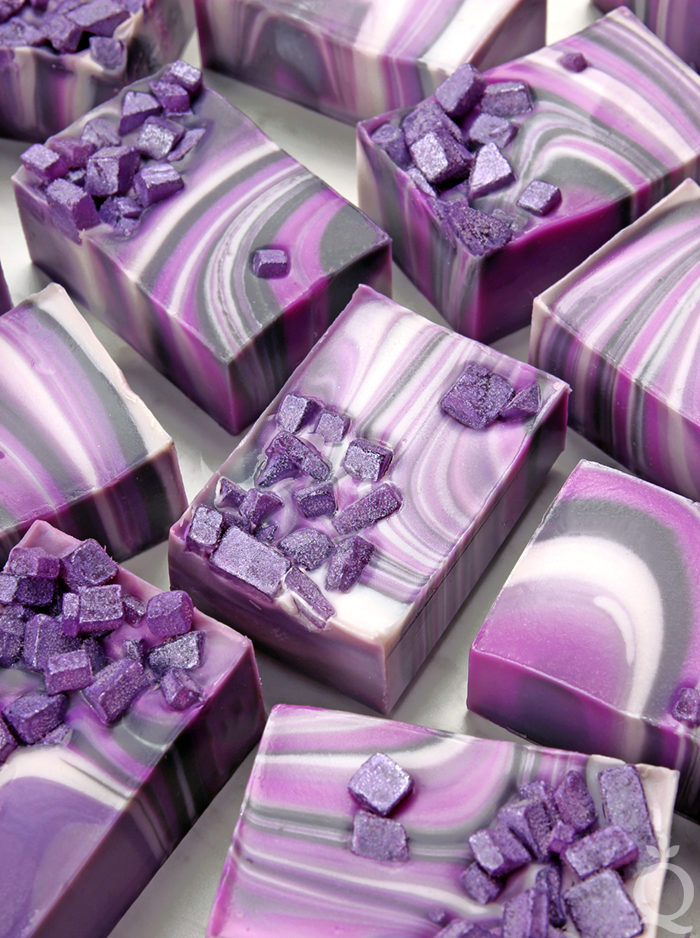
Make the Embeds
ONE: Chop and melt 10 ounces of LCP Clear Soap Base in the microwave using 10 second bursts. Once melted, add 1/4 tsp. of Lavender Mica. Stir to thoroughly mix in the colorant. Pour the soap into a mold. The exact shape doesn’t matter because the soap will be cut into pieces. We poured the soap into the 12 Cavity Rectangle Silicone Mold. Spritz with 99% isopropyl alcohol to get rid of bubbles and allow to fully cool and harden.
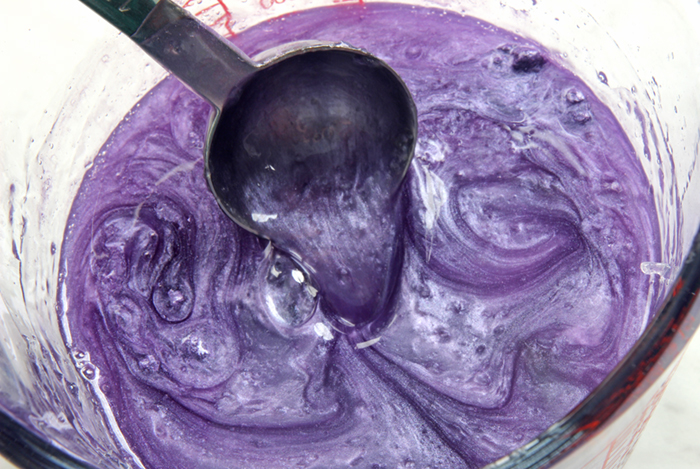 TWO: Once the soap is completely cool and firm, remove from the mold and cut into small pieces. Don’t worry about making them perfect. In fact, they look better when they are random shapes and sizes. Dust the embeds with Lavender Mica and Snowflake Sparkle Mica. Mix to completely cover the embeds. Set aside.
TWO: Once the soap is completely cool and firm, remove from the mold and cut into small pieces. Don’t worry about making them perfect. In fact, they look better when they are random shapes and sizes. Dust the embeds with Lavender Mica and Snowflake Sparkle Mica. Mix to completely cover the embeds. Set aside.
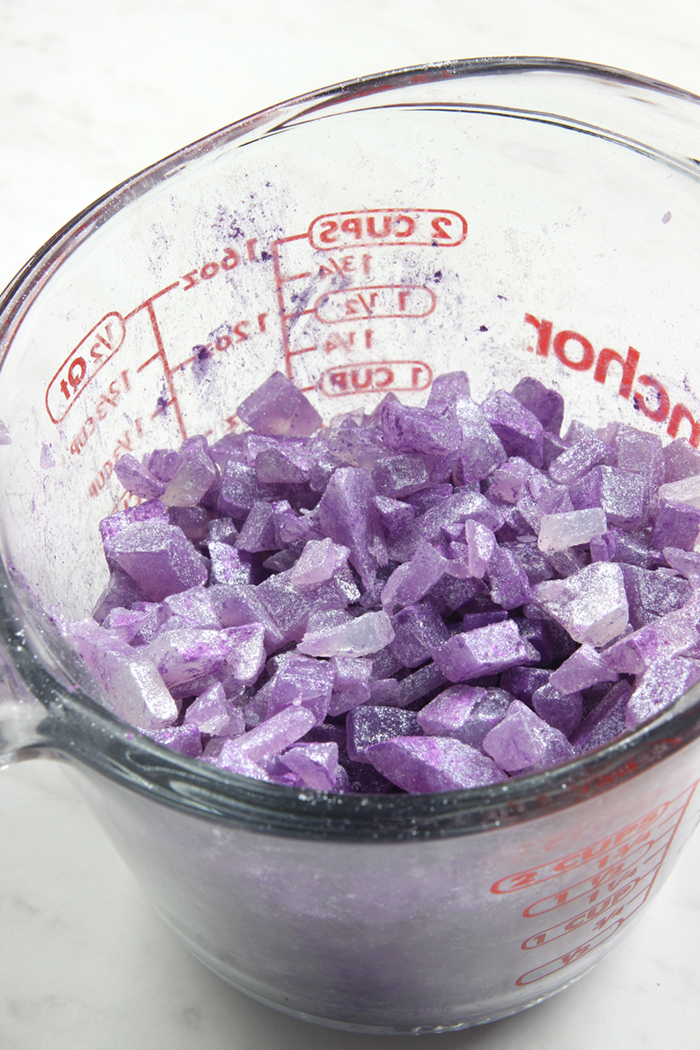
Make the Base
If you’ve never made Cold Process soap before, stop here! I highly recommend checking out our FREE four part SoapQueen.tv series on Cold Process Soapmaking, especially the episode on lye safety. And if you’d rather do some reading, Bramble Berry carries a wide range of books on the topic, including my book, Pure Soapmaking. You can also check out the digital downloads for that instant gratification factor.
SAFETY FIRST: Suit up for safe handling practices! That means goggles, gloves, and long sleeves. Make sure kids, pets, and other distractions and tripping hazards are out of the house or don’t have access to your soaping space. Always soap in a well-ventilated area.
COLOR PREP: To ensure that the titanium dioxide blends smoothly into the soap batter, we recommend micronizing it before dispersing it in oil. Please note this is an optional tip but it does help with the titanium dioxide clumping in the soap. To micronize colorant, simply use a coffee grinder to blend the colorant to break up any clumps of color and prevent streaks of white from showing in the final soap. We like to use a coffee grinder that has a removable, stainless steel mixing area for easy cleaning. Disperse 1 teaspoon of the colorant into 1 tablespoon of sunflower or sweet almond oil (or any other liquid oil).
Then in separate containers, disperse 1 teaspoon of the Lavender Mica, Queen’s Purple Mica, and Radiant Plum Colorant into 1 tablespoon of lightweight liquid oil. Finally, disperse 1/2 teaspoon of Black Oxide into 1/2 tablespoon oil. Use a mini mixer to get rid of any clumps.
FRAGRANCE PREP: Measure 3.5 ounces of Amethyst Fragrance Oil into a small glass container and set aside.
ONE: Slowly and carefully add the lye to the water and gently stir until the lye has fully dissolved and the liquid is clear. Set aside to cool. If you’d like a harder bar of soap that releases faster from the mold, you can add sodium lactate to the cooled lye water. Use 1 teaspoon of sodium lactate per pound of oils in the recipe. For this recipe, you’d add 3.5 teaspoons sodium lactate.
TWO: Melt and combine the coconut oil, apricot kernel oil, olive oil, and palm oil (remember to fully melt then mix your entire container of palm oil before portioning). Once the lye water and the oils have cooled to 130 degrees or below (and are ideally within 10 degrees of each other), add the lye water to the oils and stick blend until a very thin trace.
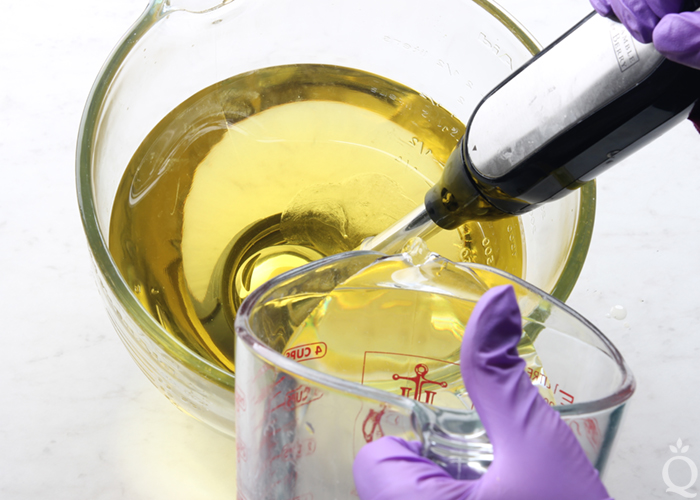
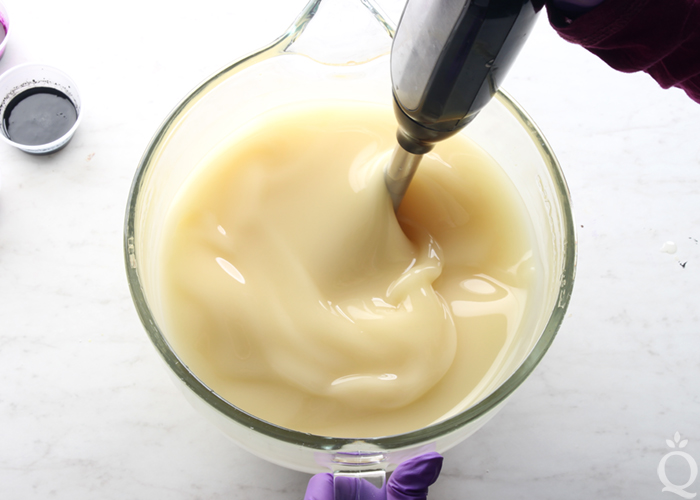 THREE: Be careful to not over emulsify the batter. The soap batter should be very thin. You can always stick blend more later. Split the batch into five containers. Three of the containers should contain 400 mL, one should contain 600 mL, and the last should contain 300 mL.
THREE: Be careful to not over emulsify the batter. The soap batter should be very thin. You can always stick blend more later. Split the batch into five containers. Three of the containers should contain 400 mL, one should contain 600 mL, and the last should contain 300 mL.
FOUR: Add the dispersed colorants to the five containers in the following amounts. To work as quickly as possible, we added the colorants directly into the containers first. Use a whisk to fully mix in the colorants.
- Container A (400 mL): All dispersed Radiant Plum Colorant
- Container B (400 mL): 2 tsp. dispersed Lavender Mica
- Container C (400 mL): 2 1/2 tsp. dispersed Queen’s Purple Mica
- Container D (600 mL): 2 tsp. dispersed titanium dioxide + 1/2 tsp. dispersed Lavender Mica
- Container E (300 mL): 1 tsp. dispersed Queen’s Purple Mica + 1/8 tsp. dispersed Black Oxide
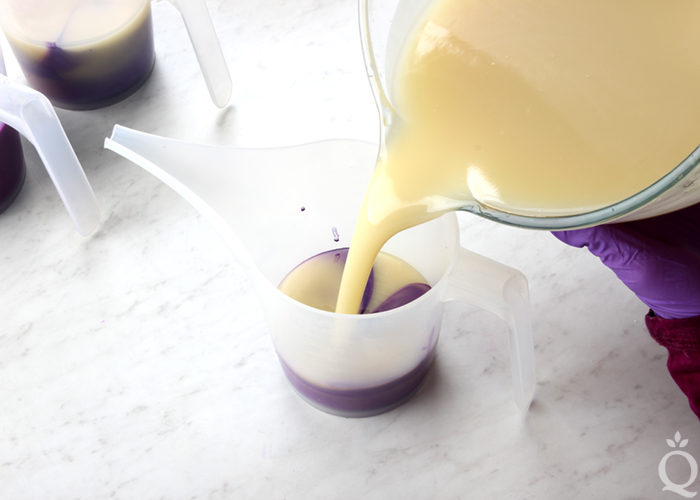
FIVE: Add the fragrance oil blend proportionally between the containers (it’s okay to eyeball it). Use a whisk to thoroughly mix in the fragrance oil. The batter should still be very thin.
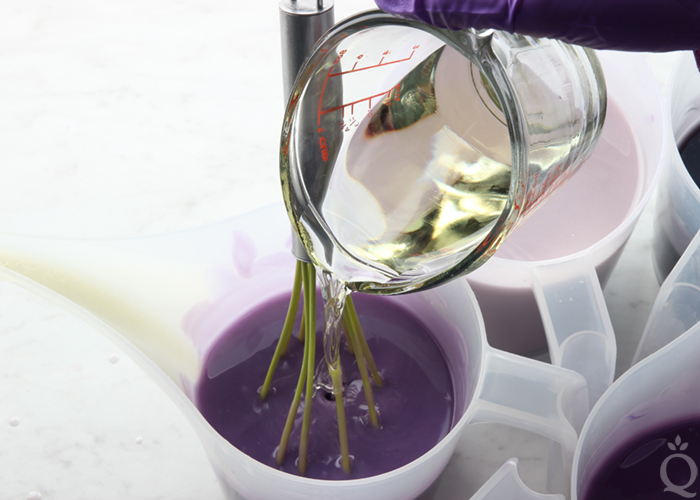 SIX: Now it’s time to pour. We like to place the mold on a Lazy Susan to help spin the soap. The order in which you pour the colors into the mold is up to you. For this soap, we did not stick to the same color order throughout. We just poured the colors into the mold depending on what looked good. With each pour, keep in mind there is less dark purple soap and more white than the other colors. Pouring the white more frequently between the purple shades gives nice contrast.
SIX: Now it’s time to pour. We like to place the mold on a Lazy Susan to help spin the soap. The order in which you pour the colors into the mold is up to you. For this soap, we did not stick to the same color order throughout. We just poured the colors into the mold depending on what looked good. With each pour, keep in mind there is less dark purple soap and more white than the other colors. Pouring the white more frequently between the purple shades gives nice contrast.
Pour a shade of purple soap into one corner of the mold. Count to three during the pour to help pour an even amount. Pour a different color in the opposite corner of the mold, counting to three to help pour evenly. Start pouring various colors into both corners of the mold. As you layer the colors, the soap is pushed toward the center of the mold. Work as quickly as possible during this process, as the soap will continue to thicken up with time. Every now and then, give the colors a whisk to help keep them fluid.
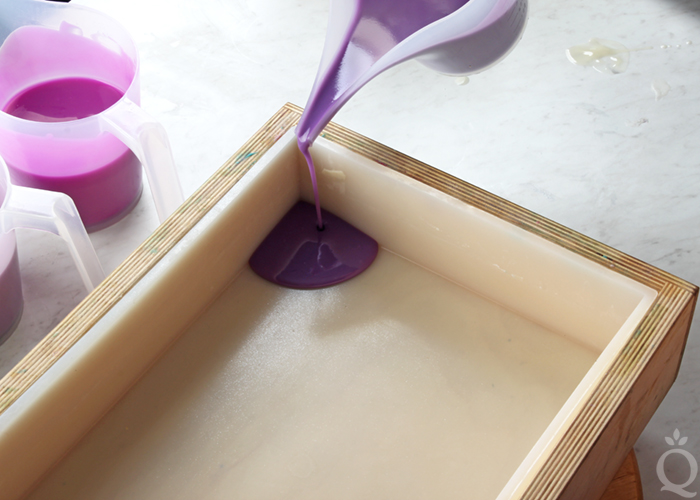
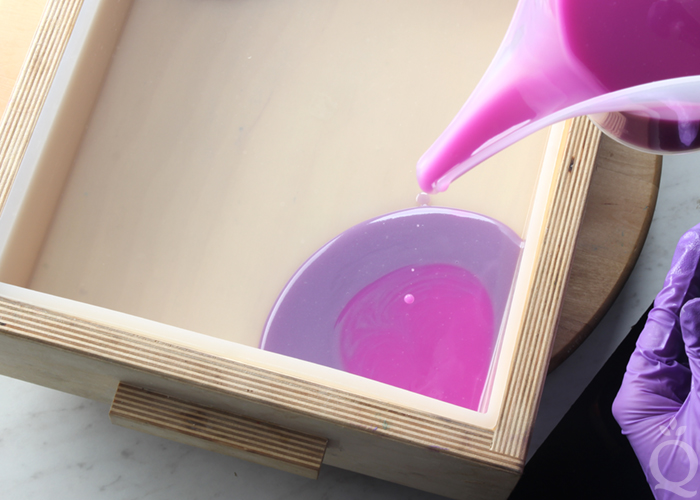
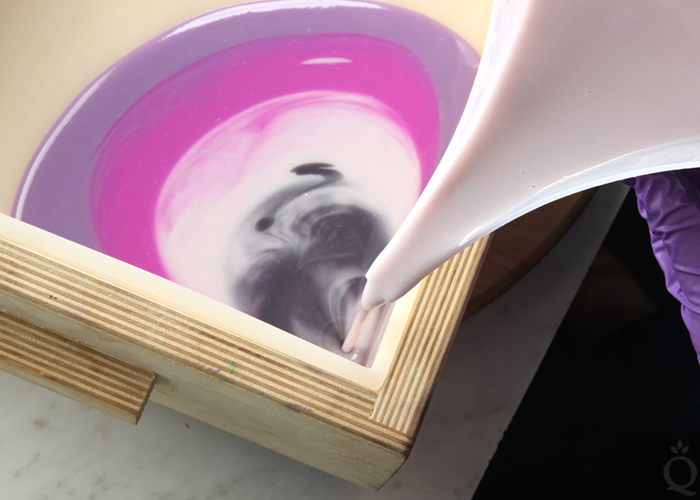 SEVEN: Once the colors meet in the center, begin pouring soap into the empty corners of the mold. Every now and then, give the mold a little shake to disperse the soap. Working quickly, continue to pour the soap in the mold until it’s gone.
SEVEN: Once the colors meet in the center, begin pouring soap into the empty corners of the mold. Every now and then, give the mold a little shake to disperse the soap. Working quickly, continue to pour the soap in the mold until it’s gone.
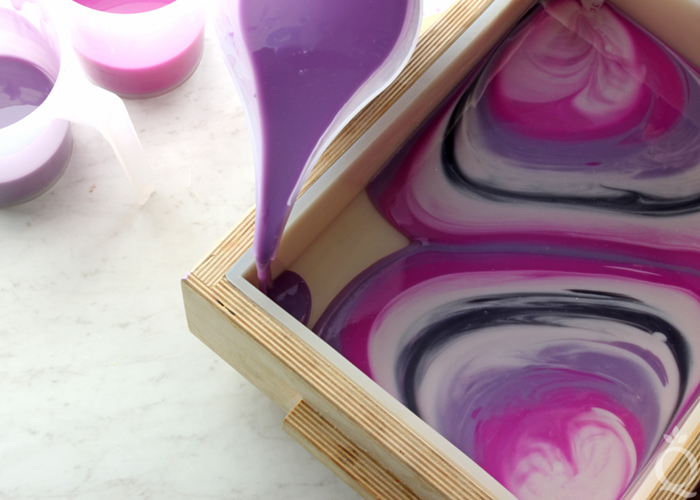
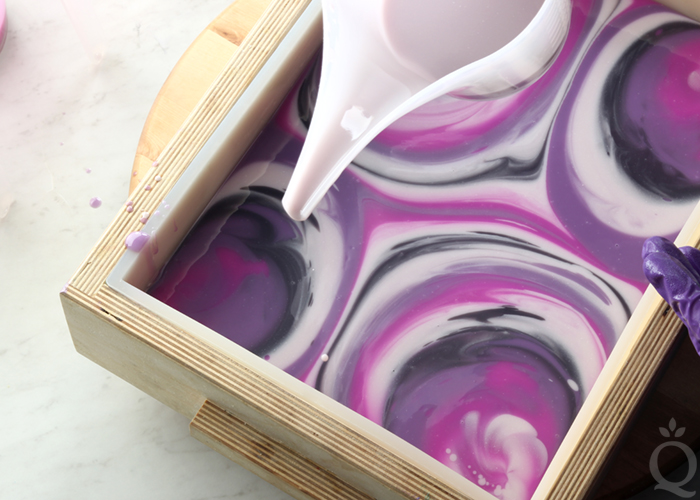 EIGHT: Give the mold a few firm taps on the counter to help eliminate air bubbles and to help the layers of soap settle. Begin to spin the Lazy Susan, stopping it quickly to help give the soap movement. You want the centrifugal force created by the spin and stop movement to move the soap in various directions within the mold. Be careful not to spin too hard, or the soap may spill out of the mold.
EIGHT: Give the mold a few firm taps on the counter to help eliminate air bubbles and to help the layers of soap settle. Begin to spin the Lazy Susan, stopping it quickly to help give the soap movement. You want the centrifugal force created by the spin and stop movement to move the soap in various directions within the mold. Be careful not to spin too hard, or the soap may spill out of the mold.
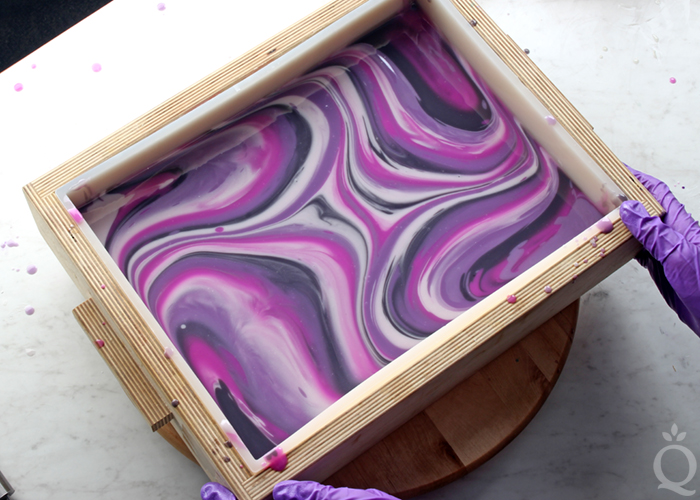 NINE: Continue swirling until you’re happy with the pattern. Be careful to not over-swirl the soap, or the colors will muddle together.
NINE: Continue swirling until you’re happy with the pattern. Be careful to not over-swirl the soap, or the colors will muddle together.
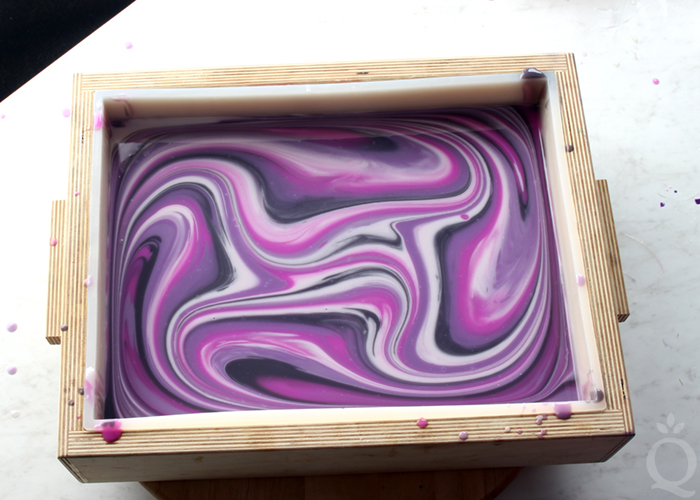 TEN: Once you’re happy with the swirl, place the divider set into the mold until it reaches the bottom. Begin placing the melt and pour pieces into the corner of each bar. Use your fingers to gently press the embeds into the soap to help them stick.
TEN: Once you’re happy with the swirl, place the divider set into the mold until it reaches the bottom. Begin placing the melt and pour pieces into the corner of each bar. Use your fingers to gently press the embeds into the soap to help them stick.
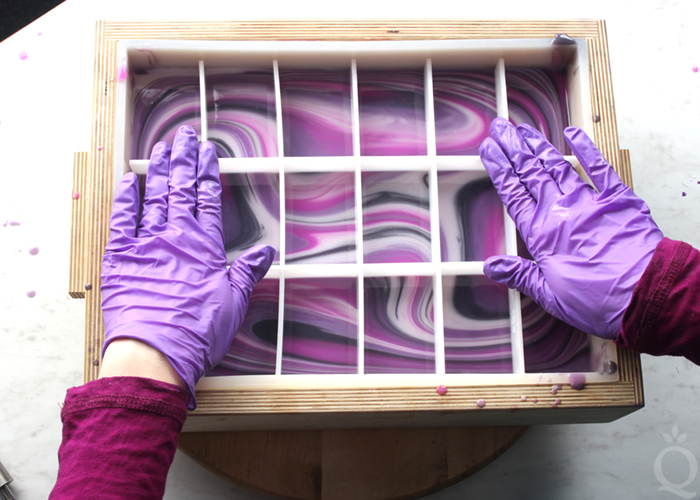 TWELVE: Continue adding the melt and pour pieces to each cavity. Once you’re done, spray the soap with 99% isopropyl alcohol to help prevent soda ash. The melt and pour embeds can melt if they become too hot, so store this soap in a cool place. Allow them to sit in the dividers for at least 3 days. Because this is a soft recipe and the soap was poured at a thin trace, it may take a little longer to unmold. But, the water discount helps speed up the process.
TWELVE: Continue adding the melt and pour pieces to each cavity. Once you’re done, spray the soap with 99% isopropyl alcohol to help prevent soda ash. The melt and pour embeds can melt if they become too hot, so store this soap in a cool place. Allow them to sit in the dividers for at least 3 days. Because this is a soft recipe and the soap was poured at a thin trace, it may take a little longer to unmold. But, the water discount helps speed up the process.
After 3 days, check to see if the silicone mold pulls away easily from the soap. If it does, remove the soap from the silicone mold. If it doesn’t, give the soap another day or two to harden. Gently remove the soap from the dividers. To prevent tearing, do not pull the dividers. Push the soap down, or slide the dividers up or down to remove the soap without tearing. Allow the soap to cure for 4-6 weeks, and enjoy!
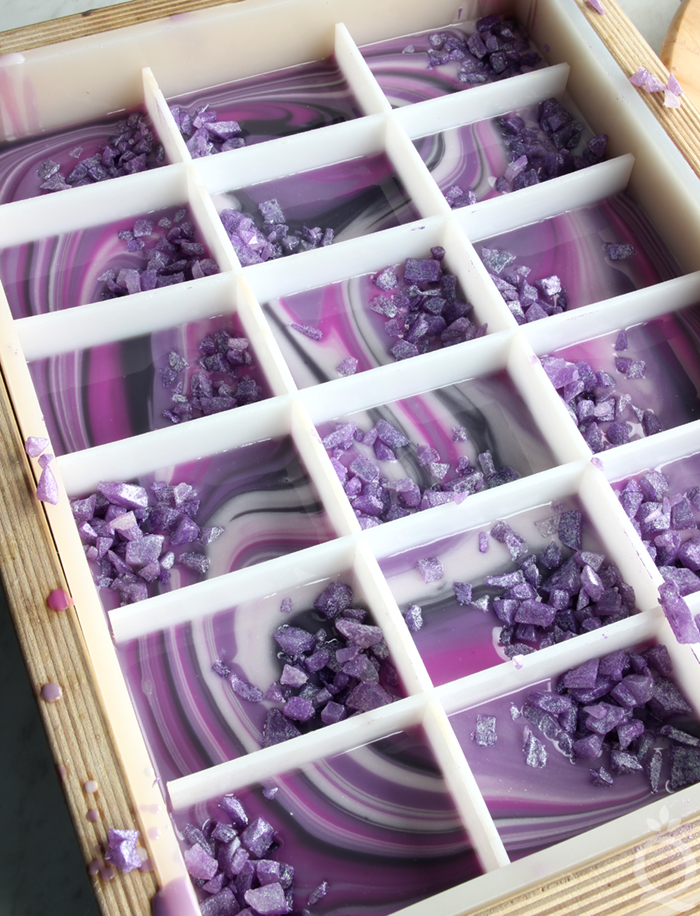
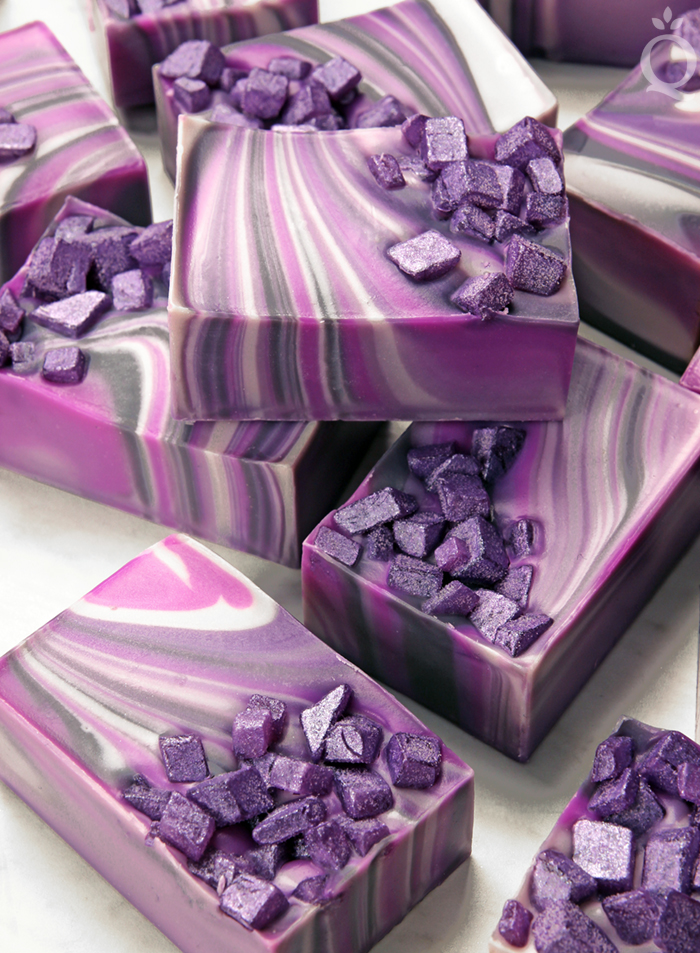
- 10 oz. LCP Clear Melt and Pour Soap
- Lavender Mica
- Snowflake Sparkle Mica
- 18 Bar Birchwood Mold
- Silicone Liner for 18 Bar Mold
- 8.1 oz. Apricot Kernel Oil (15%)
- 13.5 oz. Coconut Oil (25%)
- 21.6 oz. Olive Oil (40%)
- 10.8 oz. Palm Oil (20%)
- 7.6 oz. Sodium Hydroxide Lye
- 15.1 oz. Distilled Water (15% water discount)
- 3.5 oz. Amethyst Fragrance Oil
- Titanium Dioxide
- Black Oxide
- Queen’s Purple Mica
- Lavender Mica
- Radiant Plum Colorant
- Chop and melt 10 ounces of LCP Clear Soap Base in the microwave using 10 second bursts. Once melted, add ¼ tsp. of Lavender Mica. Stir to thoroughly mix in the colorant. Pour the soap into a mold. The exact shape doesn’t matter because the soap will be cut into pieces. We poured the soap into the 12 Cavity Rectangle Silicone Mold. Spritz with 99% isopropyl alcohol to get rid of bubbles and allow to fully cool and harden.
- Once the soap is completely cool and firm, remove from the mold and cut into small pieces. Don’t worry about making them perfect. In fact, they look better when they are random shapes and sizes. Dust the embeds with Lavender Mica and Snowflake Sparkle Mica. Mix to completely cover the embeds. Set aside.
- Slowly and carefully add the lye to the water and gently stir until the lye has fully dissolved and the liquid is clear. Set aside to cool. If you’d like a harder bar of soap that releases faster from the mold, you can add sodium lactate to the cooled lye water. Use 1 teaspoon of sodium lactate per pound of oils in the recipe. For this recipe, you’d add 3.5 teaspoons sodium lactate.
- Melt and combine the coconut oil, apricot kernel oil, olive oil, and palm oil (remember to fully melt then mix your entire container of palm oil before portioning). Once the lye water and the oils have cooled to 130 degrees or below (and are ideally within 10 degrees of each other), add the lye water to the oils and stick blend until a very thin trace.
- Be careful to not over emulsify the batter. The soap batter should be very thin. You can always stick blend more later. Split the batch into five containers. Three of the containers should contain 400 mL, one should contain 600 mL, and the last should contain 300 mL.
- Add the dispersed colorants to the five containers in the following amounts. To work as quickly as possible, we added the colorants directly into the containers first. Use a whisk to fully mix in the colorants.
Container A (400 mL): All dispersed Radiant Plum Colorant
Container B (400 mL): 2 tsp. dispersed Lavender Mica
Container C (400 mL): 2½ tsp. dispersed Queen’s Purple Mica
Container D (600 mL): 2 tsp. dispersed titanium dioxide + ½ tsp. dispersed Lavender Mica
Container E (300 mL): 1 tsp. dispersed Queen’s Purple Mica + ⅛ tsp. dispersed Black Oxide - Add the fragrance oil blend proportionally between the containers (it’s okay to eyeball it). Use a whisk to thoroughly mix in the fragrance oil. The batter should still be very thin.
- Now it’s time to pour. We like to place the mold on a Lazy Susan to help spin the soap. The order in which you pour the colors into the mold is up to you. For this soap, we did not stick to the same color order throughout. We just poured the colors into the mold depending on what looked good. With each pour, keep in mind there is less dark purple soap and more white than the other colors. Pouring the white more frequently between the purple shades gives nice contrast. Pour a shade of purple soap into one corner of the mold. Count to three during the pour to help pour an even amount. Pour a different color in the opposite corner of the mold, counting to three to help pour evenly. Start pouring various colors into both corners of the mold. As you layer the colors, the soap is pushed toward the center of the mold. Work as quickly as possible during this process, as the soap will continue to thicken up with time. Every now and then, give the colors a whisk to help keep them fluid.
- Once the colors meet in the center, begin pouring soap into the empty corners of the mold. Every now and then, give the mold a little shake to disperse the soap. Working quickly, continue to pour the soap in the mold until it’s gone.
- Give the mold a few firm taps on the counter to help eliminate air bubbles and to help the layers of soap settle. Begin to spin the Lazy Susan, stopping it quickly to help give the soap movement. You want the centrifugal force created by the spin and stop movement to move the soap in various directions within the mold. Be careful not to spin too hard, or the soap may spill out of the mold.
- Continue swirling until you’re happy with the pattern. Be careful to not over-swirl the soap, or the colors will muddle together.
- Once you’re happy with the swirl, place the divider set into the mold until it reaches the bottom. Begin placing the melt and pour pieces into the corner of each bar. Use your fingers to gently press the embeds into the soap to help them stick.
- Continue adding the melt and pour pieces to each cavity. Once you’re done, spray the soap with 99% isopropyl alcohol to help prevent soda ash. The melt and pour embeds can melt if they become too hot, so store this soap in a cool place. Allow them to sit in the dividers for at least 3 days. Because this is a soft recipe and the soap was poured at a thin trace, it may take a little longer to unmold. But, the water discount helps speed up the process. After 3 days, check to see if the silicone mold pulls away easily from the soap. If it does, remove the soap from the silicone mold. If it doesn’t, give the soap another day or two to harden. Gently remove the soap from the dividers. To prevent tearing, do not pull the dividers. Push the soap down, or slide the dividers up or down to remove the soap without tearing. Allow the soap to cure for 4-6 weeks, and enjoy!

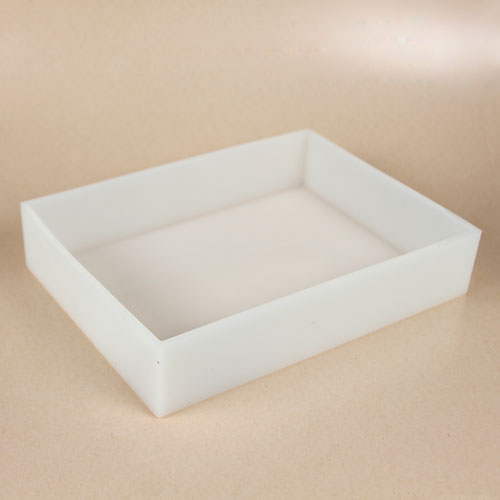
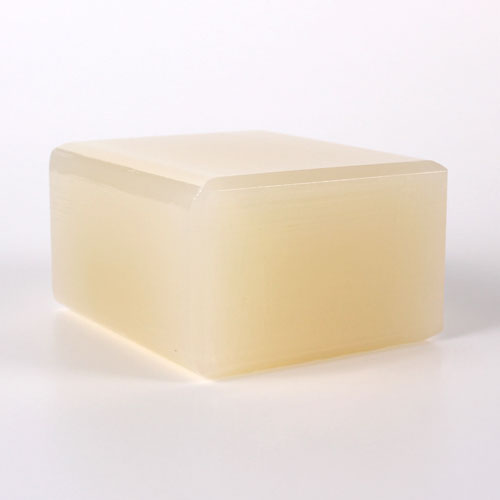
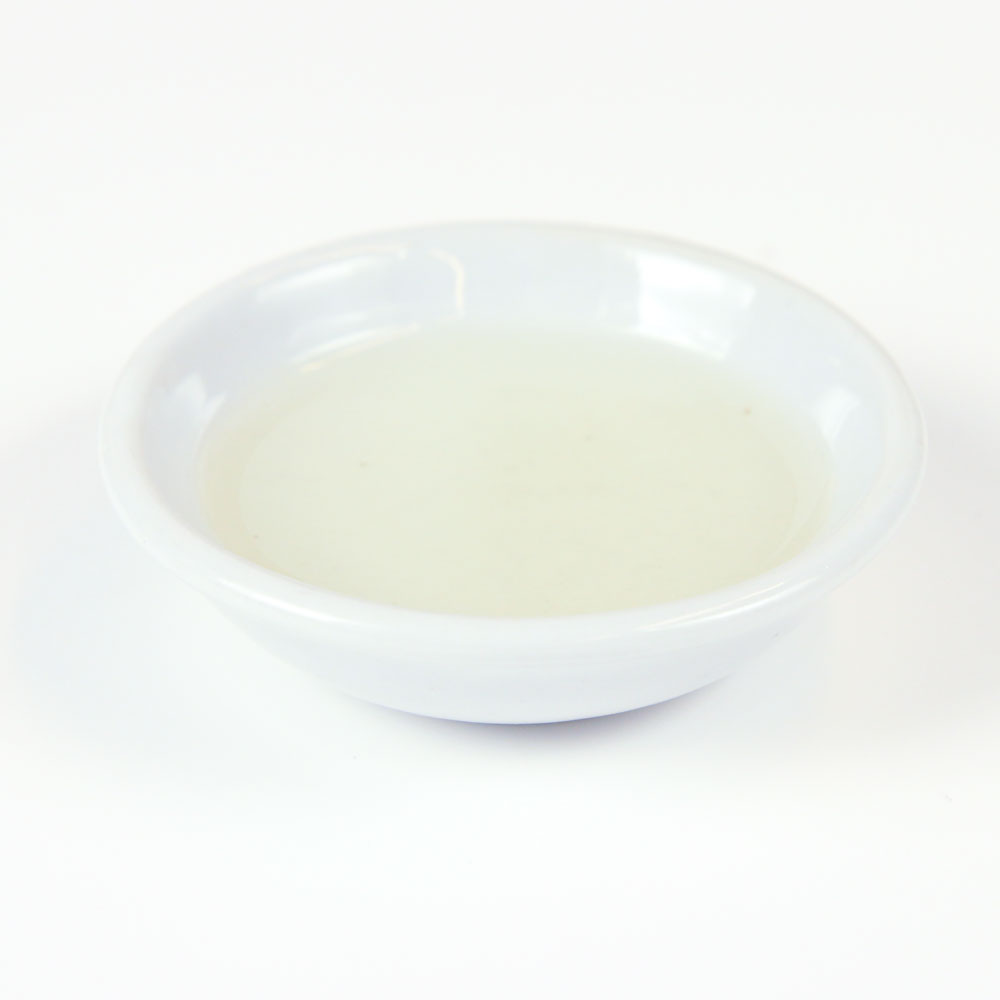
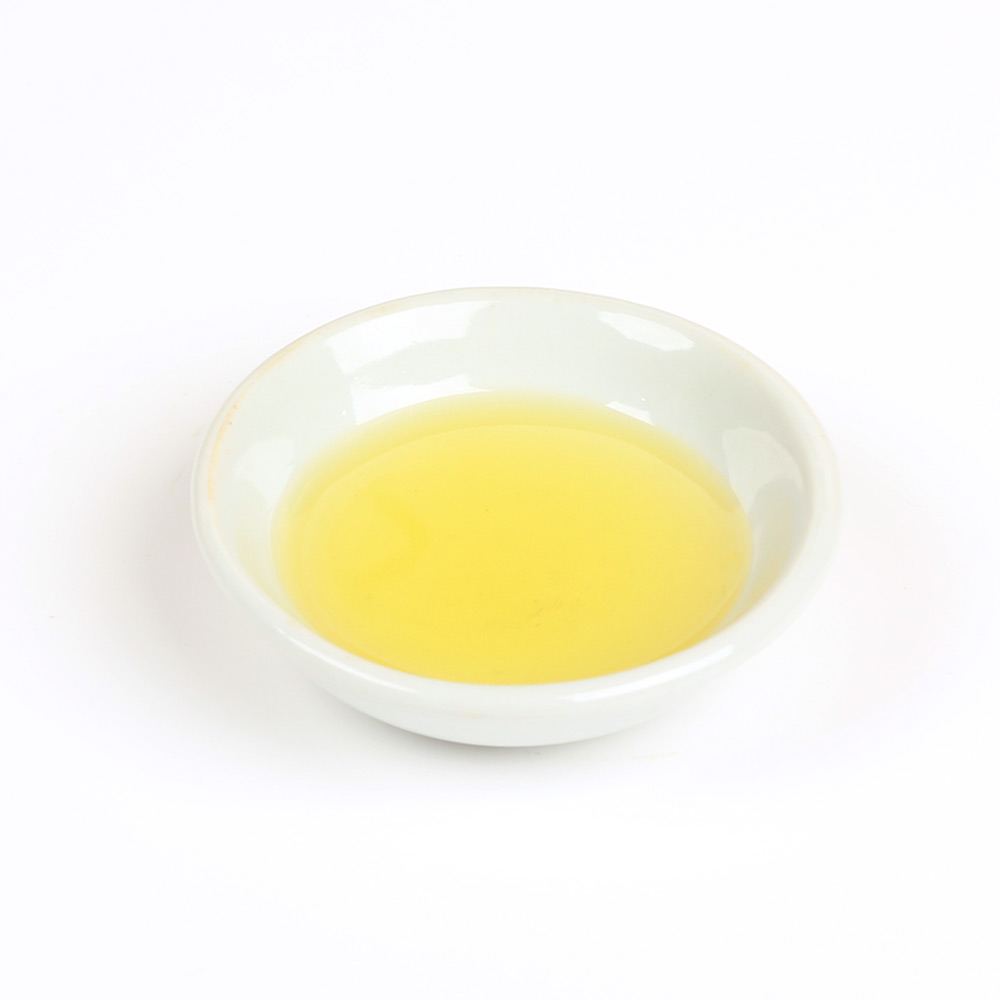
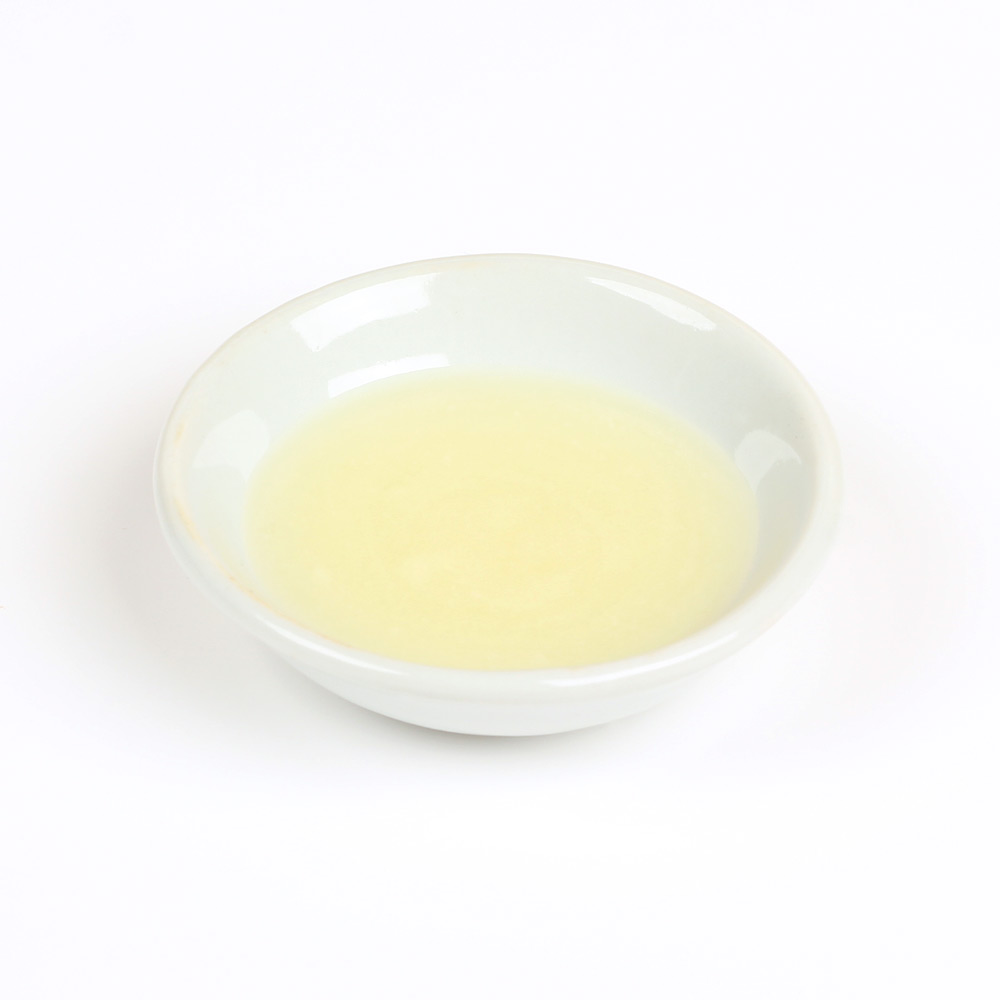
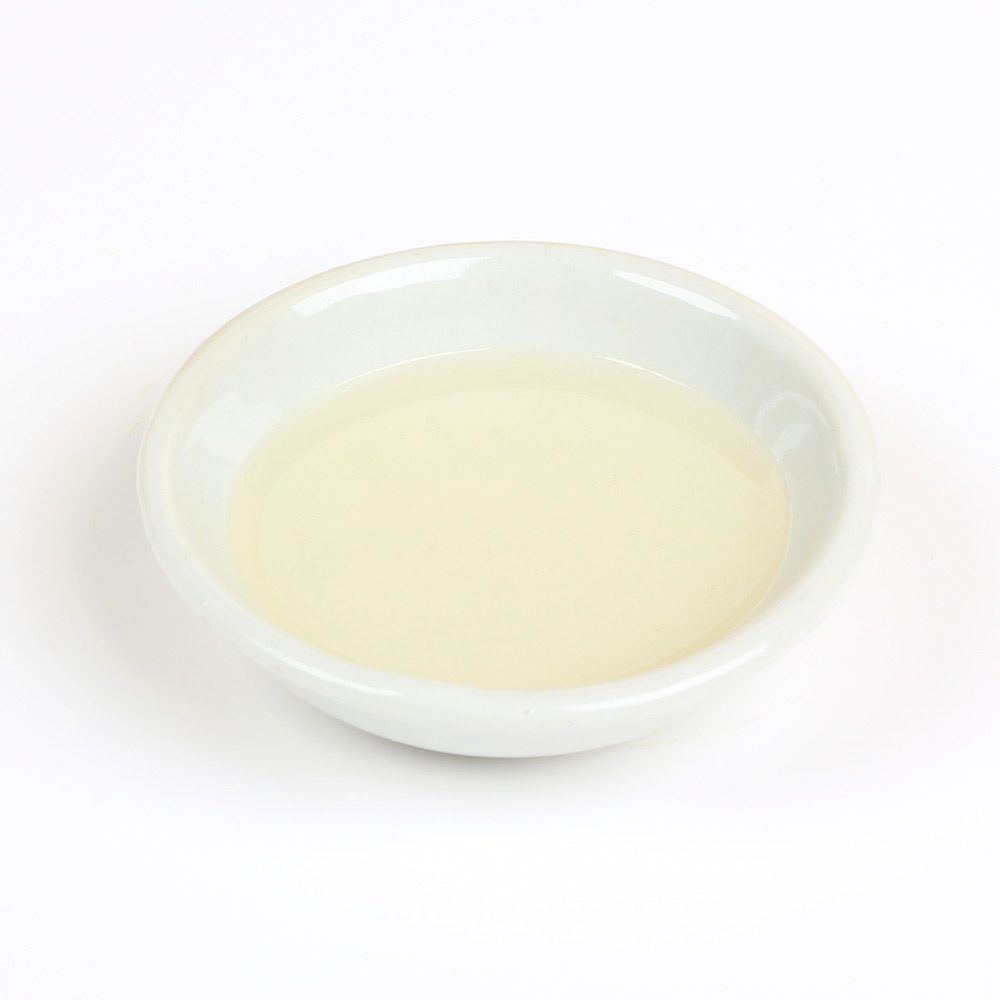
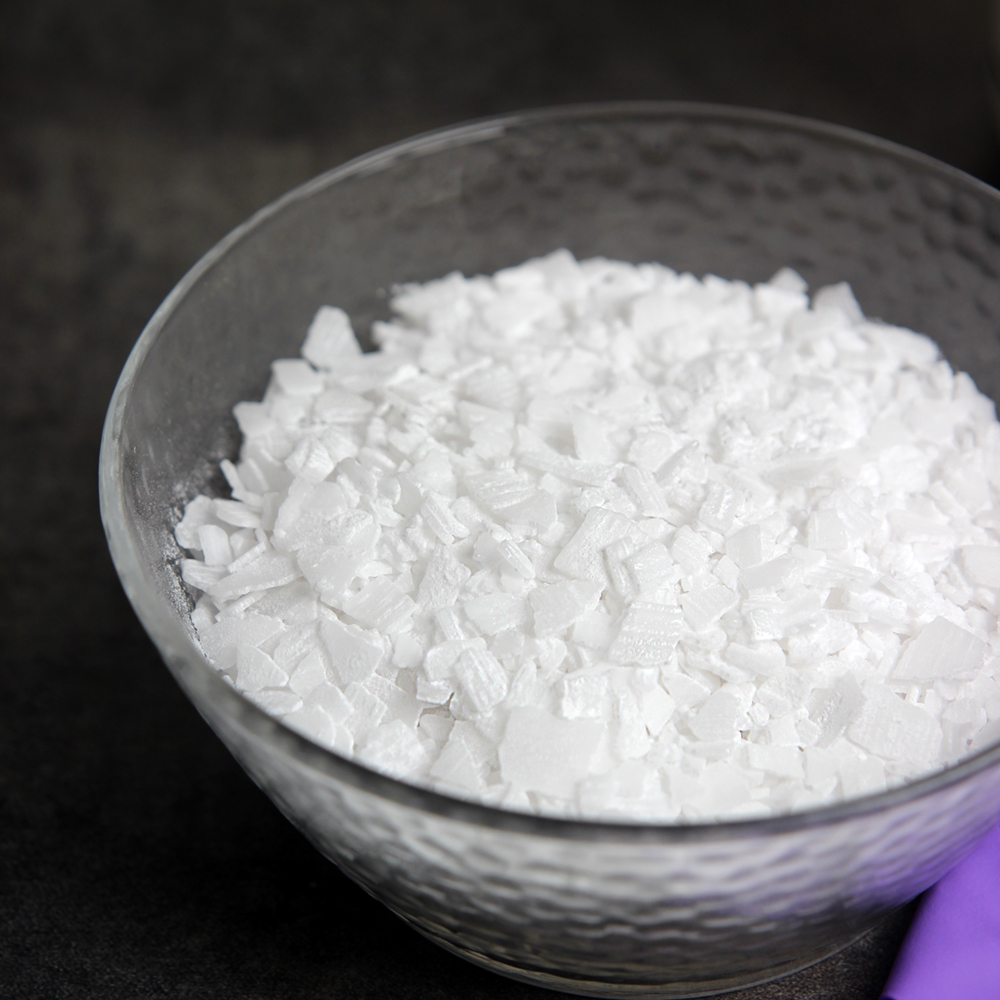
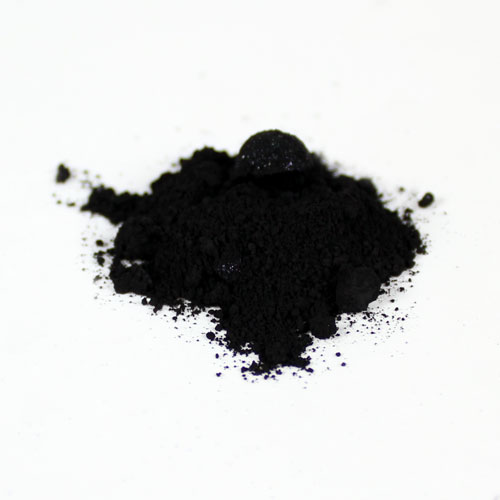
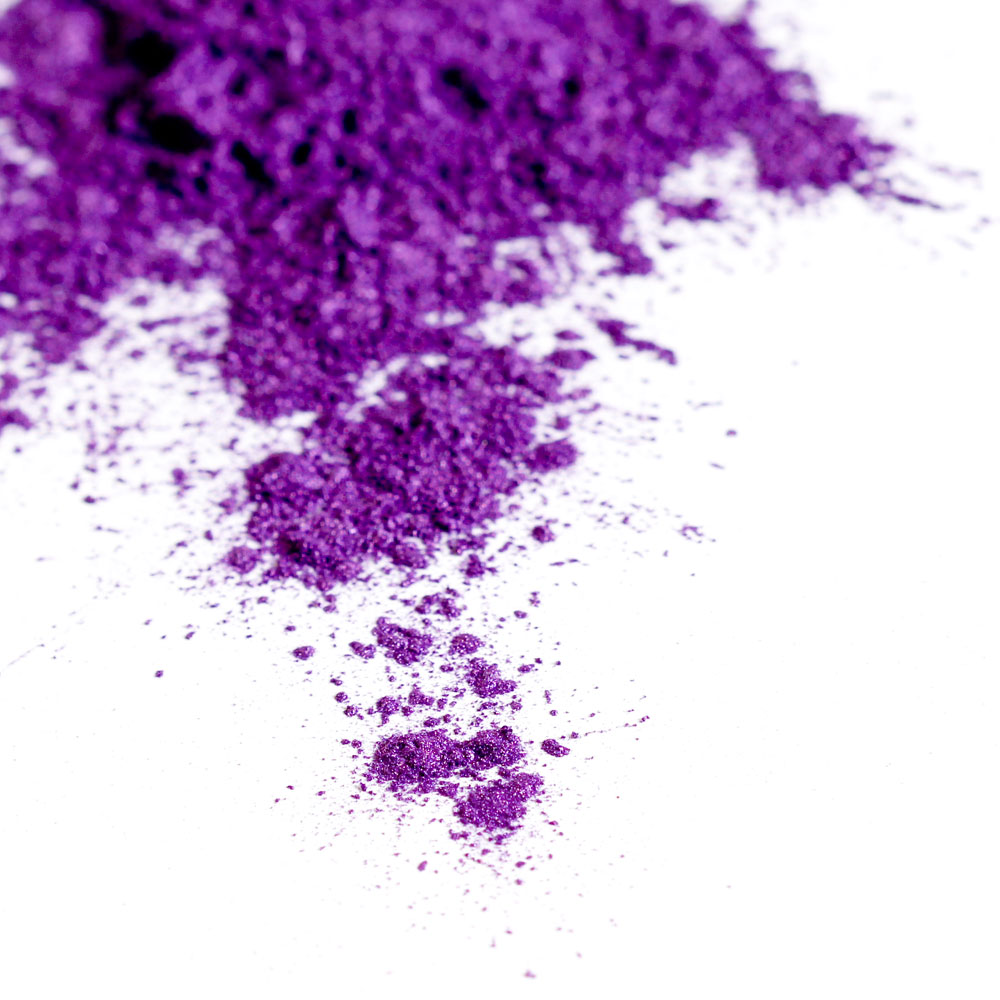


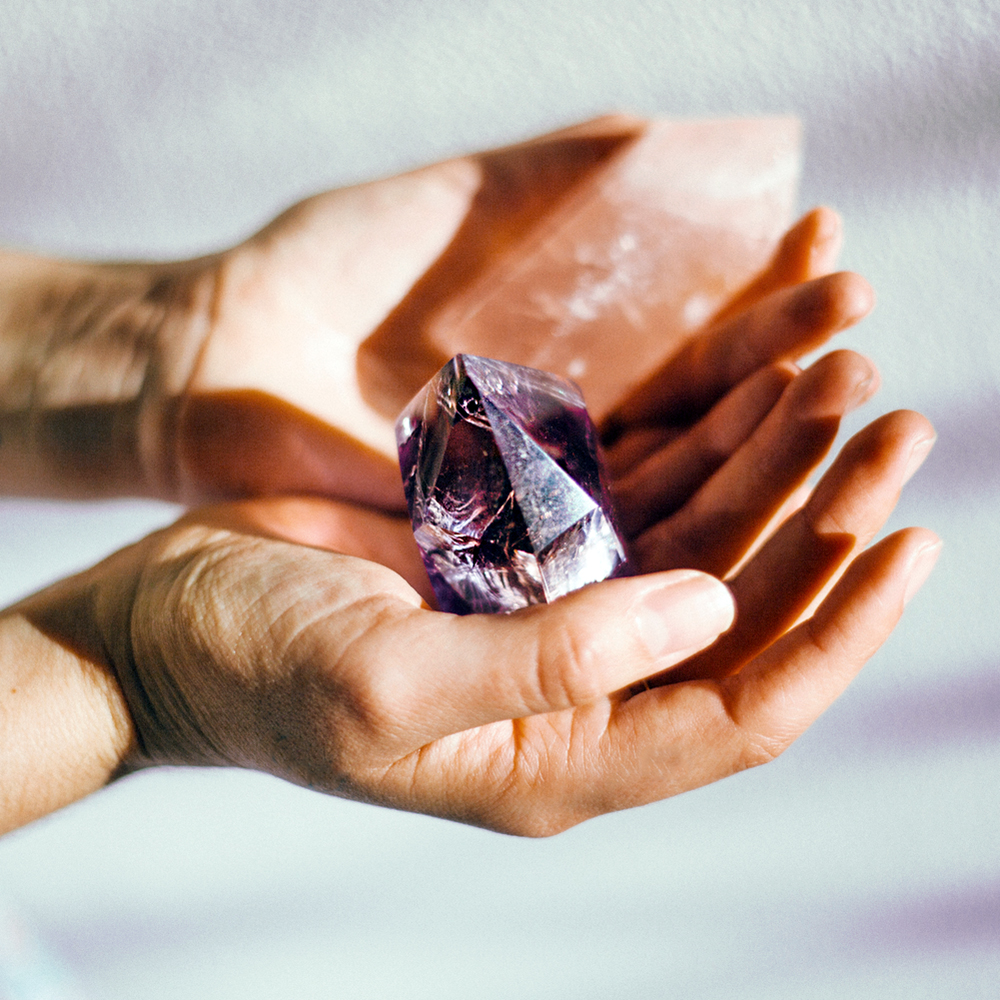

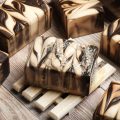

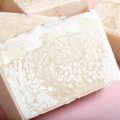
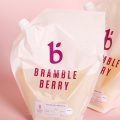
When I punch the numbers into your lye calculator with a 5% super fat the lye and water increments are incredibly different. When I input all the oils I receive an 11.16oz lye measurement. I understand the water discount. When I started looking at all your recipes and comparing the numbers to your calculator they were all very light on the lye. Why such the big difference? Especially when I’m trying to build a recipe close to your but only slightly different oils.
Running the recipe through the lye calculator with a 5% superfat comes up with 7.55 ounces of lye which we rounded to 7.6 since most scales don’t measure to the 2nd decimal.
Thank you for the reply. I’m not sure why I was using the liquid instead of solid soap type. What a goofball I am.
Hi is there a tutorial using the melt and pour soap, I’m not quite ready for the Lye stuff 🙂
Find all of our Melt & Pour Soap Recipes here: https://www.soapqueen.com/category/bath-and-body-tutorials/melt-and-pour-soap/
I am wanting to get some colorant, but I have never ordered from you before. I like bright like rainbow colors and neon colors. I was wondering what you recommend. I will be using it in cold press soap.
Thanks for your help
I think our samplers would be perfect. You can try several of our colors and once and find your favorite. I’ll link a few you may like below.
Rainbow Mica Sampler Pack: https://www.brambleberry.com/Rainbow-Mica-Sampler-Pack–P6458.aspx
Neon Colorant Sampler Pack: https://www.brambleberry.com/Neon-Colorant-Sampler-Pack-P4969.aspx
Can this be used with pour and melt. Sure hope so!Lynne
You can swirl melt and pour soap. It won’t look exactly like this tutorial, but it will look really pretty. Find out how to swirl here: https://www.soapqueen.com/bath-and-body-tutorials/tips-and-tricks/tips-for-swirling-melt-pour-soap/
Hi…
Sodium lactate has the tendency to accelerate the batter. Can I avoid it? Or shd I try using it as suggested?
We’ve found the sodium lactate doesn’t accelerate when used at 1 teaspoon per pound of oils. You can skip it if you like, your soap will just need a few extra days in the mold.
Learn more about sodium lactate here: http://www.soapqueen.com/bramble-berry-news/sunday-night-spotlight-sodium-lactate/
Hi Ma’am Anne! How are you doing? Thank you for always imparting us your awesome talent in skincare and beauty products, by the way I’m Jeanne from Philippines, i’ve been watching your videos every now and then. I’m planning to do some Whitening Soap and Lotion with Kojic Acid and I hope you could give me some good advise about it. TIA. GOD bless you always.
We haven’t worked with kojic acid so I’m not sure how to add it to your recipe. You may see if someone on teachsoap.com/forum knows more.
can I substitute Crisco for the palm oil in they recipe?
Crisco will feel different in soap. It tends to be softer than palm oil, and does vary based on what oils are being used. If you do want to use vegetable shortening, I would recommend making a small test batch with it to see what you think. You can use the shortening category on the Lye Calculator: https://www.brambleberry.com/Pages/Lye-Calculator.aspx
Is this really made 15% water discount? Does that not make it Lye heavy? Why are you recommending that water discount?
The first time we made this soap, we experienced heavy soda ash on the bars. Soda ash is more likely to occur if the soap is poured thin and temperatures are kept cool, like this batch. A water discount is the best way to prevent soda ash, and the 15% doesn’t make it lye heavy.
Luckily, even with the water discount, we were still able to create a spin swirl. Just remember to use your stick blender sparingly and work quickly.
Learn more about water discounting here: http://www.soapqueen.com/bath-and-body-tutorials/tips-and-tricks/water-discounting-cold-process-soap-how-why/
And preventing soda ash here: http://www.soapqueen.com/bath-and-body-tutorials/tips-and-tricks/explaining-and-preventing-soda-ash/
Thanks learning something new everyday
So no insulating at all with this one because of the M&P embeds. So how do you the colors to be vibrant?
We did not insulate this soap to help prevent the embeds from melting. But wood molds do naturally tend to insulate the soap. Because this batch was in a wood mold, our soap did get slightly warm, even without insulation. This caused the colors to become nice and vibrant. Once the soap is poured into the mold, I would recommend keeping an eye on it for the first few hours. If it starts to go through an intense gel phase that could melt the embeds, place it in the fridge or freezer to help keep temperatures down.
-Amanda with Bramble Berry
I used extra virgin olive oil, but its yellowish cast meant that the titanium dioxide and orchid micas were not their true colors. How can I get true colors with olive oil?
Because olive oil is a natural product, it can vary in color. If your olive oil has a dark green tint, I would recommend swapping it with rice bran oil. It has a more neutral color that may work better. You could also increase the amount of apricot kernel oil and use less olive oil if you prefer to keep it in your recipe.
-Amanda with Bramble Berry
What percentage of super fat is this recipe?
This recipe is superfatted at 5%.
-Kelsey with Bramble Berry
Superfatting Soap: An Explanation: http://www.soapqueen.com/bath-and-body-tutorials/cold-process-soap/superfatting-soap-an-explanation-2/
I used these dividers to make another recipe. I had trouble removing the soap from the dividers. Anything I could do to help in this process?
There are a few tricks to getting that soap out. First, a recipe with a lot of hard oils like coconut and palm and adding sodium lactate really help – the harder the recipe, the faster it will release. You can use 1 teaspoon of sodium lactate per pound of oils in your cooled lye water: http://www.soapqueen.com/bramble-berry-news/sunday-night-spotlight-sodium-lactate/
Learn more about formulating cold process recipes here: http://www.soapqueen.com/bath-and-body-tutorials/tips-and-tricks/formulating-cold-process-recipes/
The soap going through a pretty hot gel phase helps too: http://www.soapqueen.com/bath-and-body-tutorials/tips-and-tricks/gel-phase/
Then you’ll want to wait. After about three days, gently push down on one of the bars. If they don’t want to budge, wait a few more days until they do. When they’re ready, make sure to press down on the bars to release, rather than pulling the dividers up. See how to do that in this video: https://www.youtube.com/watch?v=PJvKaU22lzs&t=3s
-Kelsey with Bramble Berry
I noticed there is no castor in this recipe, does it still lather well?
This soap does have a more creamy lather, rather than large fluffy bubbles. If you prefer the fluffier lather, you can add castor oil at 2-5%. At higher amounts it does accelerate trace just a bit, so be prepared to work quickly.
Castor oil: https://www.brambleberry.com/Castor-Oil-P3195.aspx
-Kelsey with Bramble Berry
Wow, look at those colors! I will have to resize this to the 9 bar birchwood mold. Can I just half this recipe?
Yes, you can divide this recipe in half for the 9 Bar Mold. That will work nicely. To be extra safe, you can run it through the Lye Calculator to double check those amounts (the water will be different because of that discount: https://www.brambleberry.com/Pages/Lye-Calculator.aspx
-Kelsey with Bramble Berry
9 Bar Unfinished Birchwood Mold: https://www.brambleberry.com/9-Bar-Unfinished-Birchwood-Mold-P5169.aspx